Ciabatta Bread
This post may contain affiliate links. Read the full disclosure here.
This simple Ciabatta Bread recipe will give you a rustic Italian loaf that is perfect for dipping into soups or sauces. The high hydration in this bread results in a wonderfully chewy center and tons of irregular holes.
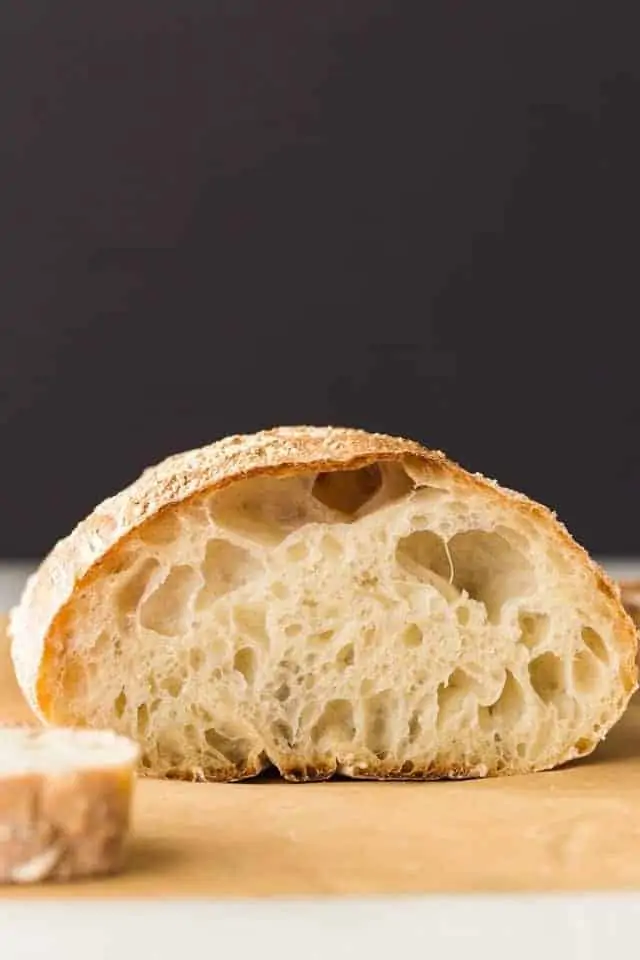
Homemade ciabatta bread
This is probably the easiest ciabatta bread recipe you’ll come across. It is an 80% hydration bread which means it’s very wet and sticky.
Because of this, you’ll need a stand mixer to make the dough. Otherwise, it will be near impossible to mix the dough.
The mixer will do all the mixing and kneading for you. This is why I say it’s the easiest recipe.
No-knead recipes are the best! I make focaccia, baguettes, pizza dough, and slow cooker bread all the time because they require little effort. And now I’ll be making ciabatta bread just as often, if not more.
Ciabatta means slipper in Italian. Can you see how the bread gets its name? It’s shaped just like a slipper!
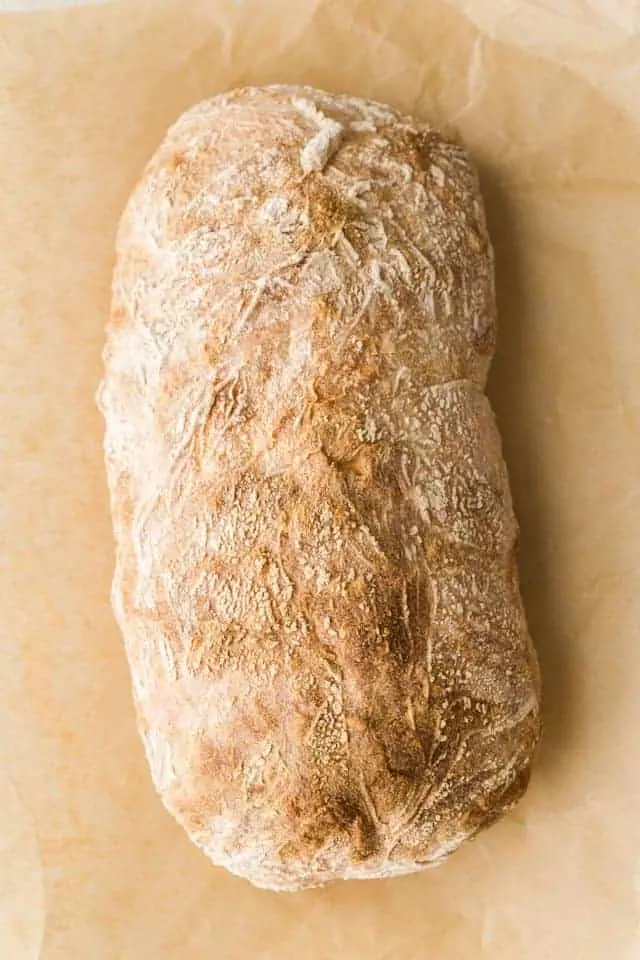
Are there eggs in ciabatta bread?
There are no eggs in ciabatta bread. It’s made with flour, water, yeast, and salt.
What do you use ciabatta bread for?
You slice ciabatta bread at an angle and drizzle it with olive oil. It can also be used for dipping in soup or soaking up a sauce.
Or you can slice it lengthwise and make an Italian Style sandwich. Whichever way you decide to enjoy this bread, I’m sure you’ll be impressed with the texture and flavor.
How do you heat up ciabatta bread?
You can heat ciabatta bread by wrapping it in aluminum foil and baking in a 350°F oven for 10-15 minutes.
Main ingredients for ciabatta bread
Bread flour – this is essential for the sturdy texture of this bread.
Yeast – you can use instant or active dry yeast. Either one will work. Just be sure to use a quality brand like Red Star®.
Water – there’s a lot of water in this bread and it’s the only liquid the recipe calls for.
Salt – salt boosts the flavor of ciabatta bread but also slows down the fermentation and enzyme activity in the dough. It helps to strengthen and support volume as well.
How to make ciabatta bread?
Step 1: Make the sponge
Combine flour, yeast, and water in a large bowl. Stir it with a wooden spoon until it’s well mixed and free of lumps.
Cover the bowl with plastic wrap and let sit at room temperature for at least 15 hours but up to 20 hours. The longer you let the sponge sit, the more flavor and structure the final bread will have.
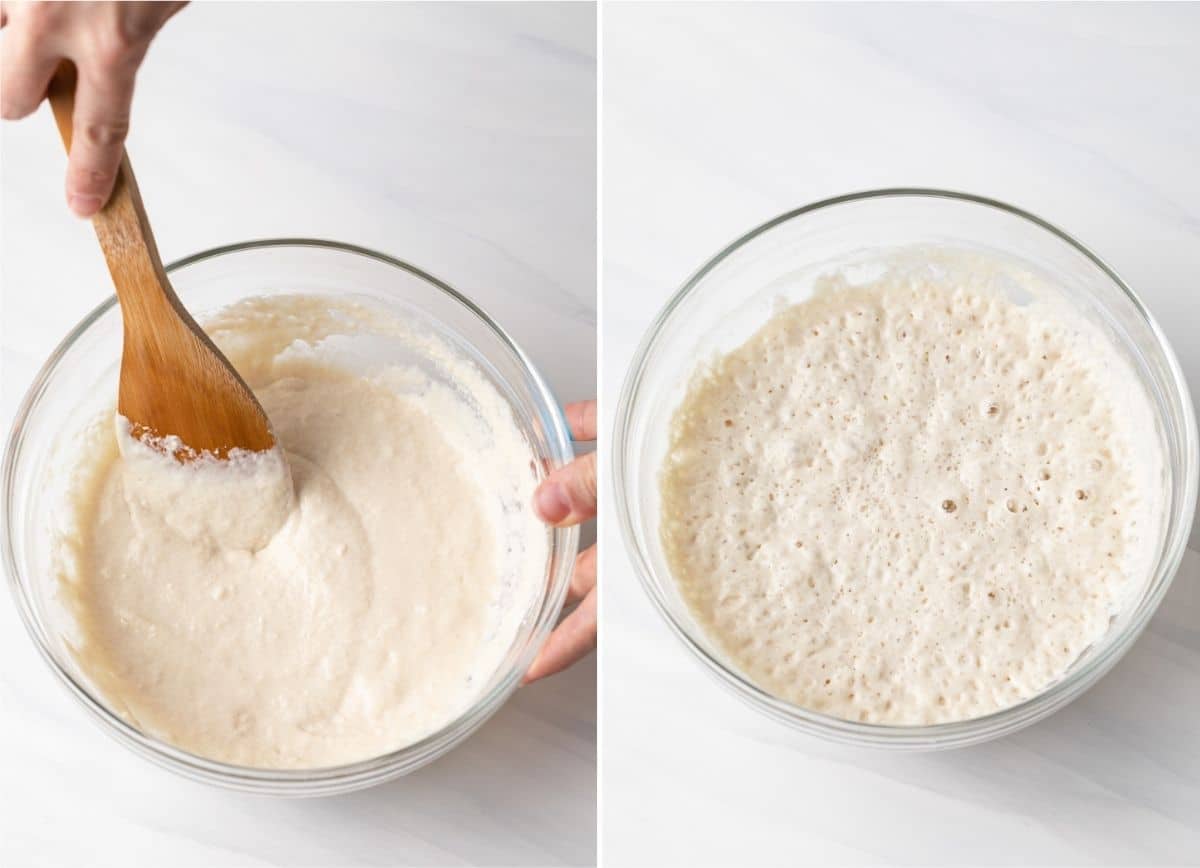
Step 2: Make the dough
In the bowl of a stand mixer, combine the sponge with more flour, water, salt, and yeast. Mix it with the dough hook until the dough no longer sticks to the sides of the bowl.
The dough will be very soft and batter-like. This is normal for ciabatta.
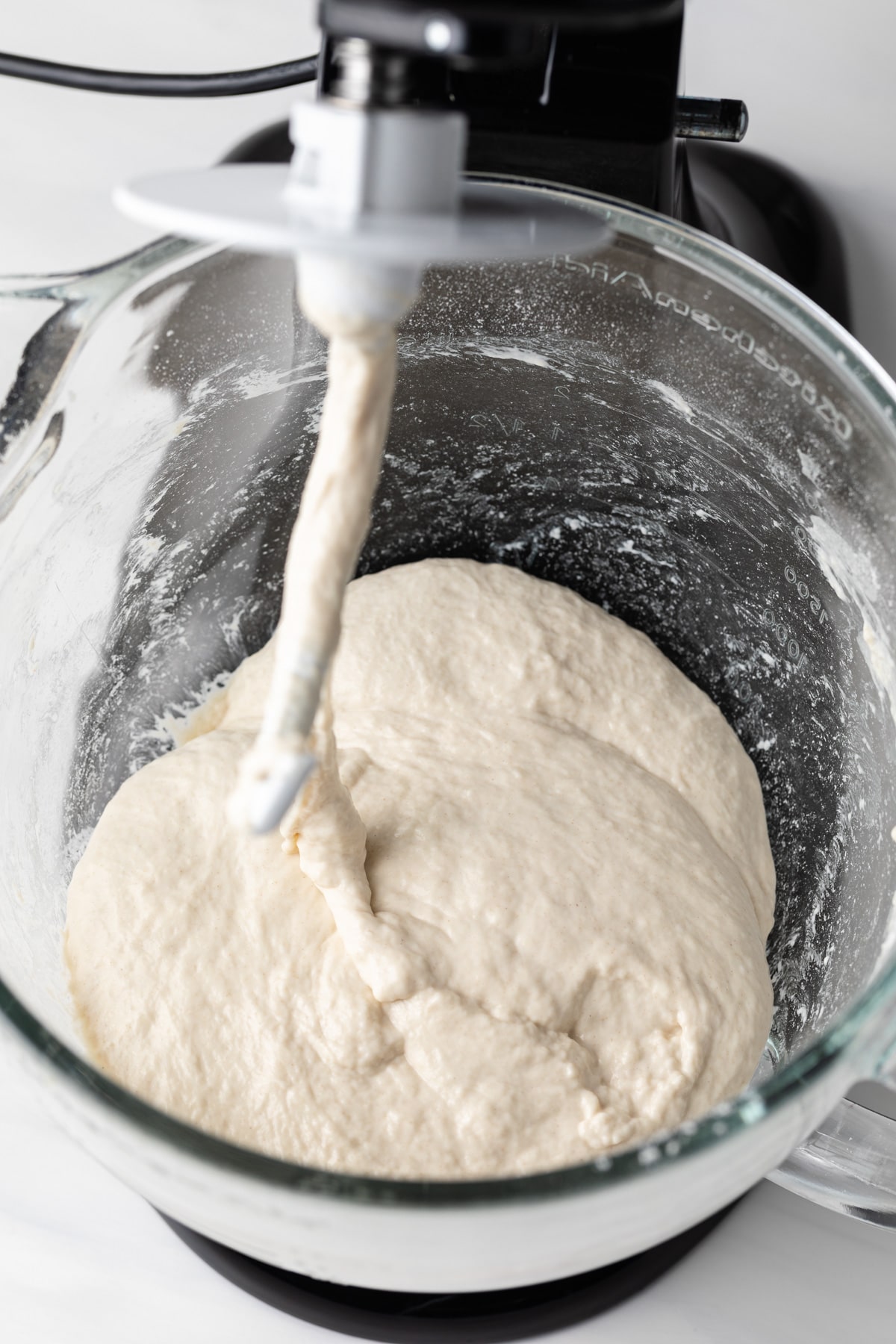
Step 3: Rise and turn the dough
Transfer the dough to a large bowl greased with olive oil. Cover and let it rise for 1 hour. Use wet hands or a greased silicone dough scraper to gently lift and fold the dough over onto itself. Flip the dough over so the top is now the bottom.
Cover the bowl and let the dough rise for 45 minutes. Repeat the folding process twice more and let rest for another 45 minutes after each.
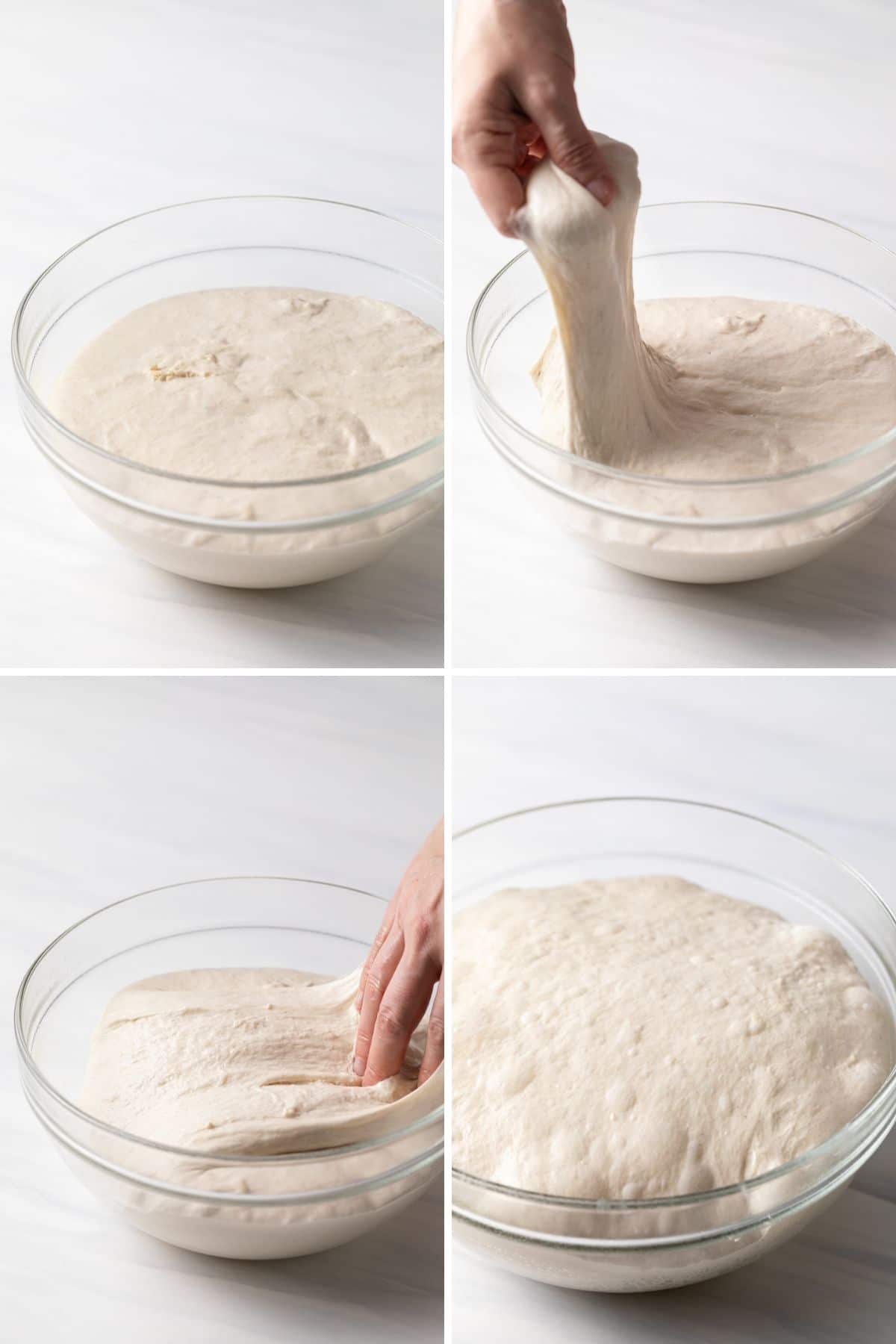
Step 4: Shape the dough
Transfer the dough to a well-floured surface and liberally flour the top of the dough. Use two well-floured bench scrapers and carefully manipulate the dough from the sides to form a square.
Don’t add any pressure to the top of the dough or it will deflate. Cut the square in half and use the bench scrapers to gently shape each half into a loaf.
Gently slide the bench scrapers under the dough and transfer each loaf to an inverted baking sheet lined with parchment paper. Cover the loaves with a cloth and let rise at room temperature for 30 minutes.
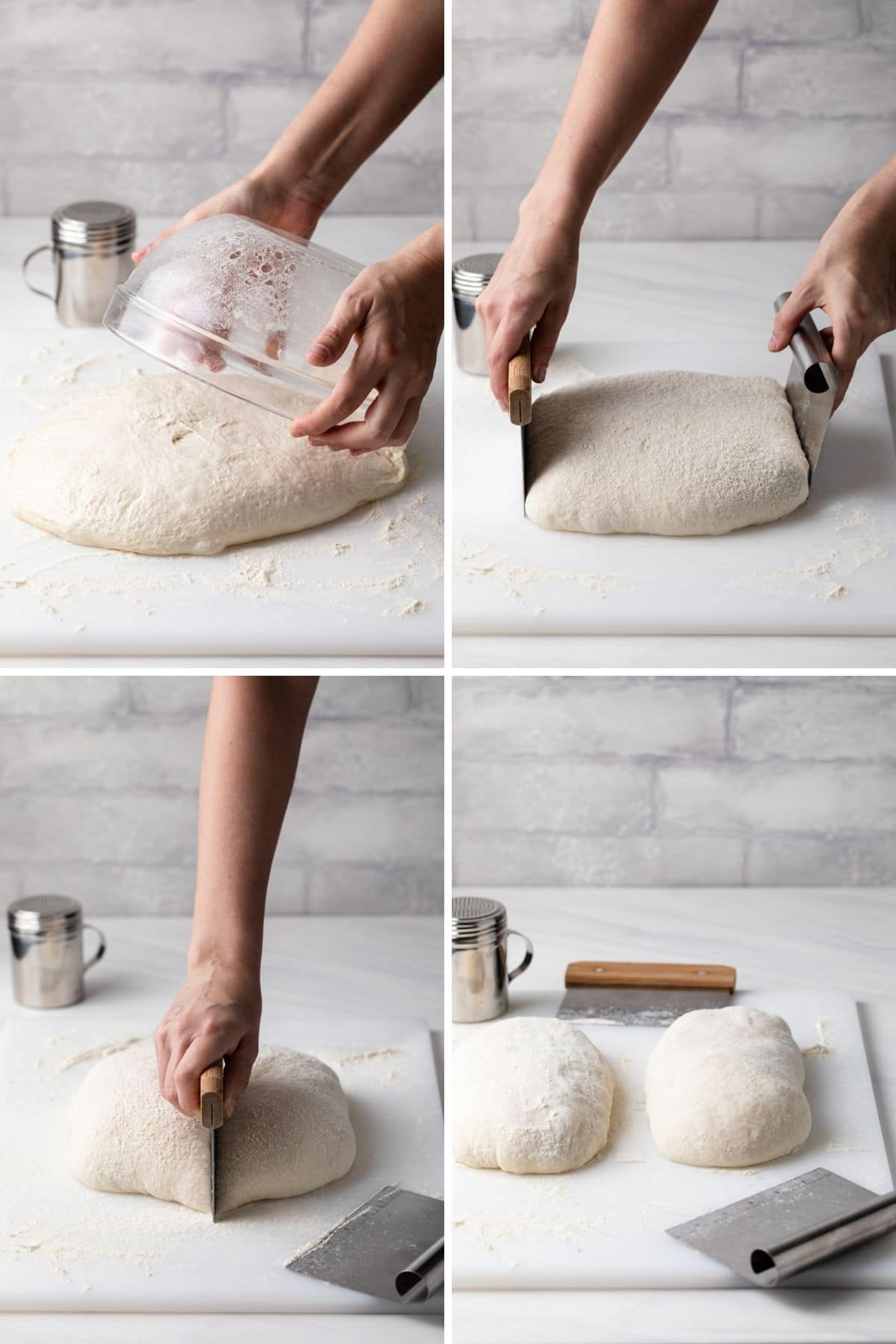
Step 5: Bake
Invert a baking sheet onto the rack just below the center of the oven and heat to 450°F.
Spray the loaves lightly with water. Then, carefully slide the parchment with the loaves onto the heated baking sheet in the oven. Bake for 25-30 minutes.
It’s important to bake with steam to create a crisp, golden crust. Do this by placing a cast iron on the lowest rack. When transferring the loaves to the oven, add 1 cup of ice to the cast iron. The ice will melt and steam during the first few minutes of baking.
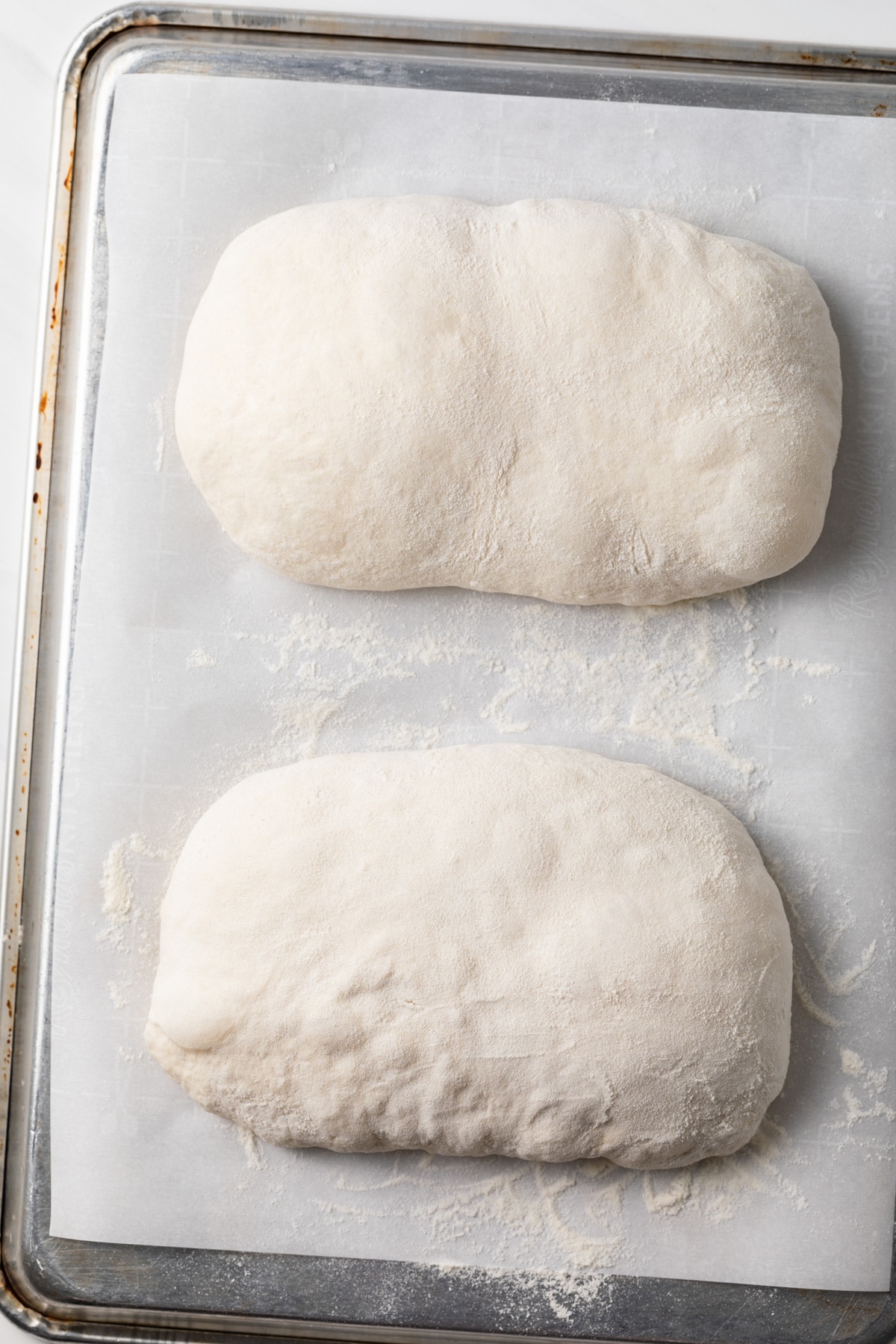
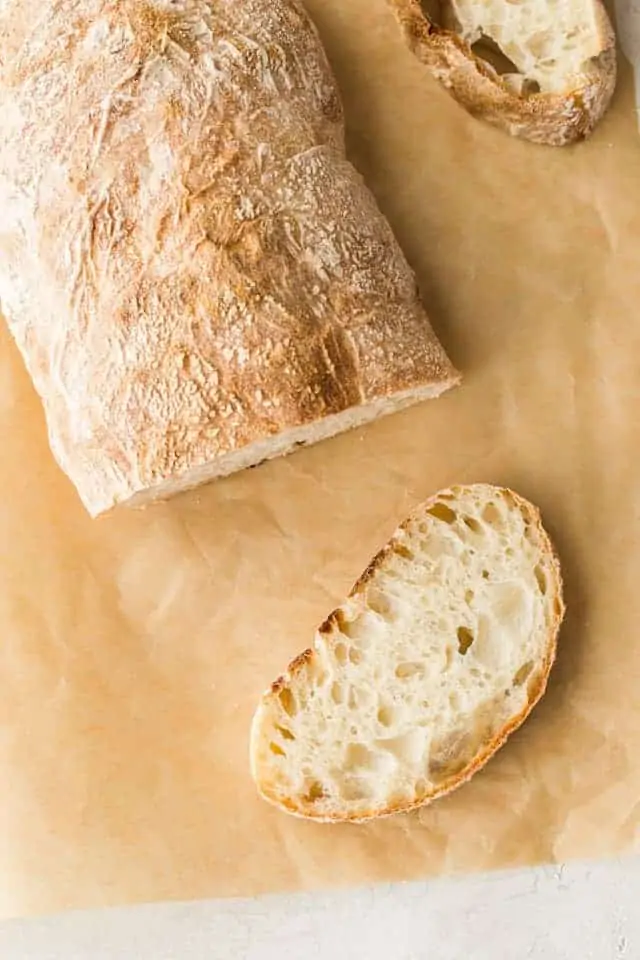
I don’t have a mixer. Can I use a food processor? Or can I mix by hand?
A stand mixer is recommended for this recipe! This dough is high in hydration, meaning it is very sticky. A stand mixer is the easiest way to mix it.
You can try mixing it with a wooden spoon and kneading it by hand but be mindful that adding more flour during kneading will affect how the bread turns out.
I don’t recommend using a food processor for mixing.
Tips for this easy ciabatta bread recipe
- Plan ahead since the sponge needs to be made a day in advance.
- The dough for this bread is very wet and sticky. It requires a lot of external flour to prevent it from sticking. If you use too much flour on the outside, you can easily brush it off before spritzing the loaf with water and baking. Just use a pastry brush* to do this.
- The dough will puff up and resemble a giant marshmallow. Be very delicate when shaping it so you don’t knock out all the air. The air is what gives the bread those gorgeous irregular holes.
More yeast bread recipes you’ll love
Some quick bread recipes you might like
- Irish Soda Bread with Raisins and Caraway Seeds
- Best Ever Banana Bread
- Cheddar Jalapeno Buttermilk Bread
Homemade Ciabatta Bread
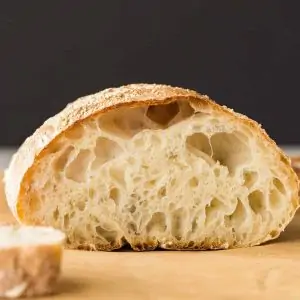
Ingredients
For the poolish
- 1 ½ cups (200 g) bread flour
- 1 scant cup (200 ml) water, room temperature
- ¼ teaspoon instant yeast
For the dough
- 2 ⅔ cups (350 g) bread flour
- 1 cup (240 ml) water, room temperature
- 2 teaspoons salt
- ½ teaspoon instant yeast
Instructions
Make the poolish
- Combine the flour, water, and yeast in a medium bowl. Stir with a wooden spoon until fully combined and the mixture is smooth. Cover with plastic wrap and allow it to ferment at room temperature for 15 to 20 hours.
Make the dough
- Add the poolish and all ingredients for the dough to the bowl of a stand mixer fitted with the paddle attachment. Mix on low speed until all the flour is moistened, about 2 minutes. Increase the speed to medium-low and mix until dough forms into a mass and pulls away from the sides of the bowl, about 6 minutes.
- Switch to the dough hook attachment and mix on medium-low until dough becomes smooth and shiny, about 10 minutes. The dough will be soft, wet, and sticky much like batter.
- Lightly coat the inside of a large bowl with olive oil or nonstick spray. Use a silicone dough scraper to scrape the dough into the bowl. Cover with plastic wrap and let rise for 1 hour at room temperature.
- Using a greased scraper or damp fingertips, gently grab one side of the dough, lift and stretch it over the top of itself. Turn the bowl 180 degrees and stretch the same way. Rotate 90 degrees, stretch and fold. Rotate 180 degrees to stretch and fold the final side. Flip the dough over so the bottom becomes the top. Cover with plastic wrap and let rest at room temperature for 45 minutes. Repeat folding two more times, then cover with plastic wrap and let sit for an additional 45 minutes after each.
- Adjust the oven racks so that one is in the lower-third position (just below the center) and one is at the very bottom position. Place a cast-iron skillet on the lowest rack and an inverted baking sheet on the upper rack. Heat the oven to 450°F. It’s important to let the oven preheat for at least an hour to ensure it is hot enough.
- Liberally dust your work surface with flour and let the dough slide out of the bowl onto the counter. Be very gentle here so you don’t knock all the air out of the dough and try to handle the dough as little as possible. Liberally dust the top of the dough with flour. Using 2 well-floured bench scrapers, carefully manipulate the dough from the sides to form a square. Take care not to put pressure on top of the dough.
- Cut the dough in half, down the middle of the square. Gently shape each half into loaves by using the bench scrapers to manipulate the sides.
- Invert a large baking sheet and place a sheet of parchment paper across the top. Dust liberally with flour. Using both bench scrapers, slide them under both ends of the dough and transfer the dough to the prepared parchment paper. Repeat with the remaining loaf. Use your fingertips to gently poke the surface of each loaf as you shape it into a rectangle.
- Cover with a lint-free cloth to prevent the loaves from drying out. Proof in a draft-free place until puffy and the surface develops small bubbles, about 30 minutes.
- Have 1 cup of ice ready. Mist the loaves with water and carefully slide the parchment with loaves on the heated baking sheet in the oven using a jerking motion. Immediately drop the ice into the cast-iron pan on the bottom rack. Quickly close the oven door.
- Bake, until the crust is a deep golden brown, about 25-35 minutes. The internal temperature of the bread should be 210-215°F.
- Transfer to a rack to cool completely before slicing and serving
Notes
- It’s very important to measure the ingredients correctly! While I do list cup measurements, if you do not measure accurately, the dough will not form properly. For 100% success with this recipe, please use the weight measurements. This is a soft, sticky dough. It’s difficult to work with and requires patience.
- This is a 80% hydration bread. If you have difficulty working with the dough, lower the hydration to 70% by using 3 ¼ cups (422 g) flour in the dough.
- You may bake the bread on an oven stone if you prefer. Place it in the oven to preheat in step 5.
- Shaping ciabatta: This is meant to be an easy recipe with limited handling. Because of this, it can be difficult to build surface tension around the dough to hold in the gas. If you continuously have trouble with getting large irregular holes in the bread, then it’s because the gas is escaping. Make sure you are adequately stretching and folding to build up the surface tension.
- Wrap completely cooled bread in aluminum foil and it will keep for up to 2 days at room temperature. The crust will soften but can be toasted if you wish to crispen it up.
- The bread will stay fresh for up to 3 months if stored in the freezer. Wrap the cooled loaves in double layers of plastic wrap followed by double layers of aluminum foil. Reheat the frozen loaves as desired in the oven.
- I don’t recommend refrigerating the bread. Oftentimes, this will dry it out.
Nutrition
The nutrition information provided is for convenience and as a courtesy only. It is not guaranteed to be accurate because nutrition information can vary for a variety of reasons. For precise nutritional data use your preferred nutrition calculator and input the exact ingredients and brands you used in the recipe.
This recipe has been updated with a few tweaks to ensure everyone has success. I’ve added additional yeast and there’s also less handling of the dough which prevents the air from being knocked out.
Adapted from On Baking and Bread Illustrated.

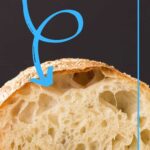
i’ve tried this recipe before & it worked out perfectly. thanks for a great recipe. however, this time around, i’ve already made the poolish yesterday & just realised that i don’t have enough bread flour to carry on with the recipe. can the poolish be fermented longer than 20 hours at room temp. or should i refrigerat it?
I don’t recommend leaving the poolish at room temperature for longer than 20 hours. You can try refrigerating it but I can’t guarantee the bread will turn out as intended.
i printed your recipe in june of 2020. great recipe. got dirty so i went to reprint today and there are differences. original for sponge says use 240g water, and refrigerate. todays recipe says use 200g of water and leave at room temperature. you also add 1/2 teaspoon of yeast, i add 1/4 tsp, to make the bread, but the original recipe did not add yeast. why the differences?
I had countless people complain of failure with the original recipe. When this happens, I always revisit the recipe to find a way to make it successful for everyone. These slight differences don’t change the final product but they ensure each person who makes it will have better results.
@Jen Sobjack, That’s odd – I tried a batch tonight with the current measurements and it came out so wet it was unworkable – I know it’s supposed to be wet, but it couldn’t even be shaped.
Sometimes it just comes down to environment and type of ingredients as well.
Yes, certainly environment and the ingredients used can make a huge difference. The updated recipe is slightly less hydration than the original. It’s still a difficult dough to handle which is why there are step-by-step photos and a video to show readers how the dough should look throughout the process.
Hi, I only have active dry yeast and was just wondering whether I should follow the measurements in the recipe (1/4 tsp yeast for poolish), or the suggested amounts of the pack of the pack (15g yeast per 500g flour)and split this between poolish & dough? Thanks
Follow the measurements in the recipe. Just be sure your yeast is good.
This is the first time making this particular recipe (I’ve made ciabatta before). The dough didn’t seem to rise much between each folding.. I’m on the last rest of 30 minutes, and the dough is pretty flat (with some noticeable bubbles). Yes, the yeast is fresh; yes, I weigh my ingredients (always)…. don’t know what happened. I just watched the video and my dough was much wetter than it looked on the video.
I’m hoping for a good rise for the last rest and fingers crossed for decent loaves!
The way you are describing the dough sounds like you are on the right track. There should be noticeable bubbles and the dough will not rise much during the proofing stages. It really puffs up once it hits the heat of the oven. It’s a high hydration bread so it’s going to be wet and very sticky. I use a good amount of flour on the outside of my loaves to prevent them from sticking, which is why they don’t look as wet. Rice flour works best for this. This recipe gets a ton of positive reviews so I hope you enjoy the loaves!
I’ve done this recipe a few times now and they turn out lovely. The only difference is I bake them in 12″ foil tins, lined with parchment, as I don’t have the scrapers. I just divide the completed dough between them using a spatula. They come out great.
When I use a scale and put 200g of bread flour in a bowl then added 200ml of water from my measuring cup + yeast, it is not enough water. Had to add more. Am I doing something wrong. Thanks
Don’t add more water to the sponge. Just keep stirring until the flour becomes hydrated. As it sits, the flour will soak in the water and look more like a sponge. See the video for visual cues.
I read I could have used my baking stone instead of the inverted pan. But, I didn”’t. I found it very difficult to get the bread off the parchment and slide them onto the inverted pan. As a result, the parchment went in along with the bread. Could I have done my shaping and cutting on my peal and then slide the bread onto the stone?
I haven’t tasted the bread yet. It doesn’t look much like other ciabattas I’ve seen. I hope it’s good.
I slide the parchment paper with the loaves onto the inverted pans in the oven. There’s no need to remove the bread from the paper. Even with a stone, the parchment paper would need to go in with the loaves. Unless you proof the loaves directly on the peel with a lot of flour to prevent them from sticking.
It took me two tries. Rookie mistake first time – I measured instead of weighed but 2nd time was perfect. Crisp exterior, lovely and delicious loaves. I made a double batch, 4 loaves, almost the same amount of time and energy as for two loaves. I rolled and shaped my risen dough into loaves directly onto the floured parchment paper, cut the parchment to separate the loaves and then lifted each onto the pre-heated stone. Followed the directions otherwise. Easy and rewarding recipe!
I accidentally bought dry yeast instead of instant…will that be an issue?
Active dry yeast is perfectly fine to use also. Make sure to activate it in warm water before mixing with the flour.
Just waiting for the poolish/biga to ferment so I will update with my results tomorrow but seems very straight forward, I am also going to cut into smaller rolls as there for work.